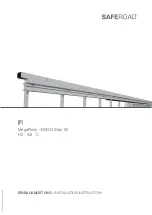
Warner Electric • 800-825-9050
P-273-5 -WE • 819-0529
11
A good practice to follow is to check for power at the
lead wires to the clutch or brake using a voltmeter .
• If power is present in the proper voltage and
current, then skip ahead to the Mechanical
Troubleshooting Section .
• If power is not present, inspect the lead wires for
breaks or cuts .
• If the wires are intact, the problem may be with
the power supply or the switch .
• Using a voltmeter, check to see that voltage is
leaving the power supply and that the switch is
sending power to the clutch or brake .
• Finally, if there is no power leaving the switch or
power supply, check the incoming AC power to
insure that it is reaching the power supply .
Troubleshooting - Mechanical
A likely mechanical cause for a clutch or brake not
engaging when DC power is applied is that the air-
gap between the friction faces is too large . When
power is applied to an Electro-magnetic clutch/brake,
the unit magnetically clamps the friction faces togeth-
er . An airgap that is too large can keep the unit from
clamping together . If the airgap is too small the faces
will rub all of the time .
To adjust the airgap, see Section C on page 5 .
Enclosed Electro-Module Options
Vented Warner Electric Electro-Module and base
assemblies can be oriented as necessary to keep
contaminates from entering the open housing vents .
If an Enclosed Electro-Module (10-20, 10-40, 20-30,
30-40, 10-20FBC, 20FBC-30) is required an optional
Cover Kit, Warner Electric part number 5370-101-
076, can be purchased separately to enclose the
open vents in the housing . Each Cover Kit includes
two (2) vent covers and four (4) screws needed to
convert a vented Electro-Module to an enclosed
design (non-washdown) as shown in Figure 12a .
Scan to Watch
Cover Kits Video
https://p.widencdn.net/xrhdfr
Electrical Coil Data
Clutch
Brake
Clutch
Brake
Voltage-D .C .
90
90
24
24
Resistance
EM-50
452
429
31 .8
28 .8
(OHMS)
EM-100/180
392
308
26 .7
21 .7
Current
EM-50
.20
.21
.76
.83
Ampheres)
EM-100/180
.23
.29
.90
1 .1
Power
EM-50
18
19
19
20
(WATTS)
EM-100/180
21
27
22
27
Coil Build Up
EM-50
52
40
52
40
Time (ms)
EM-100/180
72
80
72
80
Coil Decay
EM-50
6
5
6
5
Time (ms)
EM-100/180
12
8
12
8
Mechanical Data
EM-50 EM-100/180
Static Torque - lb . ft .
16
30
Maximum Speed - rpm
3600
3600
Average Weight - lbs .
20
9 .2
11 .2
10-20
15 .6
18 .7
10-40
14 .0
16 .6
20-30
18 .4
21 .7
30-40
16 .8
19 .5
Inertia - WR - lb.ft.
2
Configuration
50 100/180
20 output
.0195
.050
10-20 input
.021
.047
10-20 output
.0195
.050
10-40 input
.021
.047
10-40 output
.0105
.027
20-30 input
.021
.047
20-30 output
.0195
.050
30-40 input
.021
.048
30-40 output
.0105
.027
































